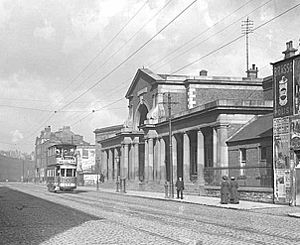George Wilkinson (architect) facts for kids
Quick facts for kids
George Wilkinson
|
|
|---|---|
| Born | 1814 |
| Died | 1890 |
| Nationality | British |
| Occupation | Architect |
| Buildings | Harcourt Street Railway Station in Dublin |
George Wilkinson was a skilled English architect. He worked mostly in Ireland. He was born in Witney, Oxfordshire, in 1814. George was the older brother of William Wilkinson, who was also an architect. William worked in Oxford.
Contents
George Wilkinson's Career
Designing Important Buildings
George Wilkinson began his career by winning a design contest in 1835. He designed a "workhouse" for the Thame area. A workhouse was a place where poor people could live and work. This building later became part of a college.
Wilkinson went on to design 24 workhouses in England. Many of these had an H-shaped layout. Some examples include the workhouses at Northleach (1835) and Woodstock (1836–1837). He also designed the Tenbury workhouse (1837) with a special double courtyard plan.
For two workhouses, Witney (1835–1836) and Chipping Norton (1836), he used a unique design. It had four wings spreading out from an eight-sided central area. For the Wolverhampton workhouse, he changed this design to have six wings. In 1839, George Wilkinson was asked to come to Ireland. He became the main architect for the Poor Law Commission there. This group helped manage aid for the poor.
Building Railway Stations
Wilkinson also designed several railway stations. He designed the station in Multyfarnham, County Westmeath. He also created an Italianate style station at Crossdoney in County Cavan around 1855. Other stations he designed include the Cavan town terminus (1862) and the famous Harcourt Street Railway Station in Dublin (1858–1859).
Later Life and Legacy
In 1845, Wilkinson published a book. It was called Practical Geology and Ancient Architecture of Ireland. This book showed his knowledge of both building and the land.
George Wilkinson married Mary Clinch in Witney on December 18, 1850. Mary was the daughter of John Williams Clinch, a well-known brewer and banker from Witney. In 1878, George became a Fellow of the Royal Institute of British Architects. This was a great honor for his work.
Wilkinson retired to England around 1888. He passed away in Twickenham on October 4, 1890. His designs, especially his workhouses and railway stations, left a lasting mark on architecture in both England and Ireland.


